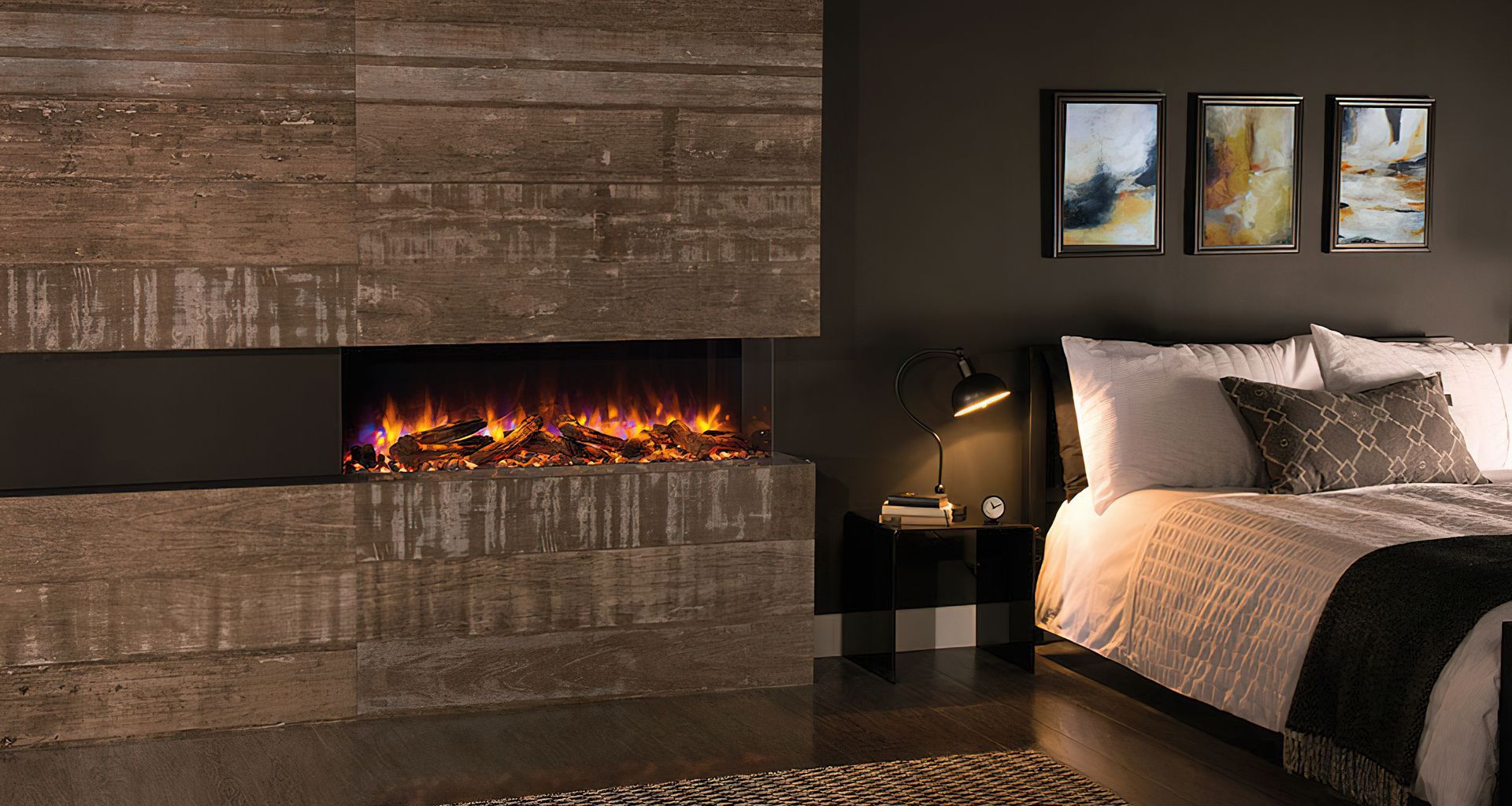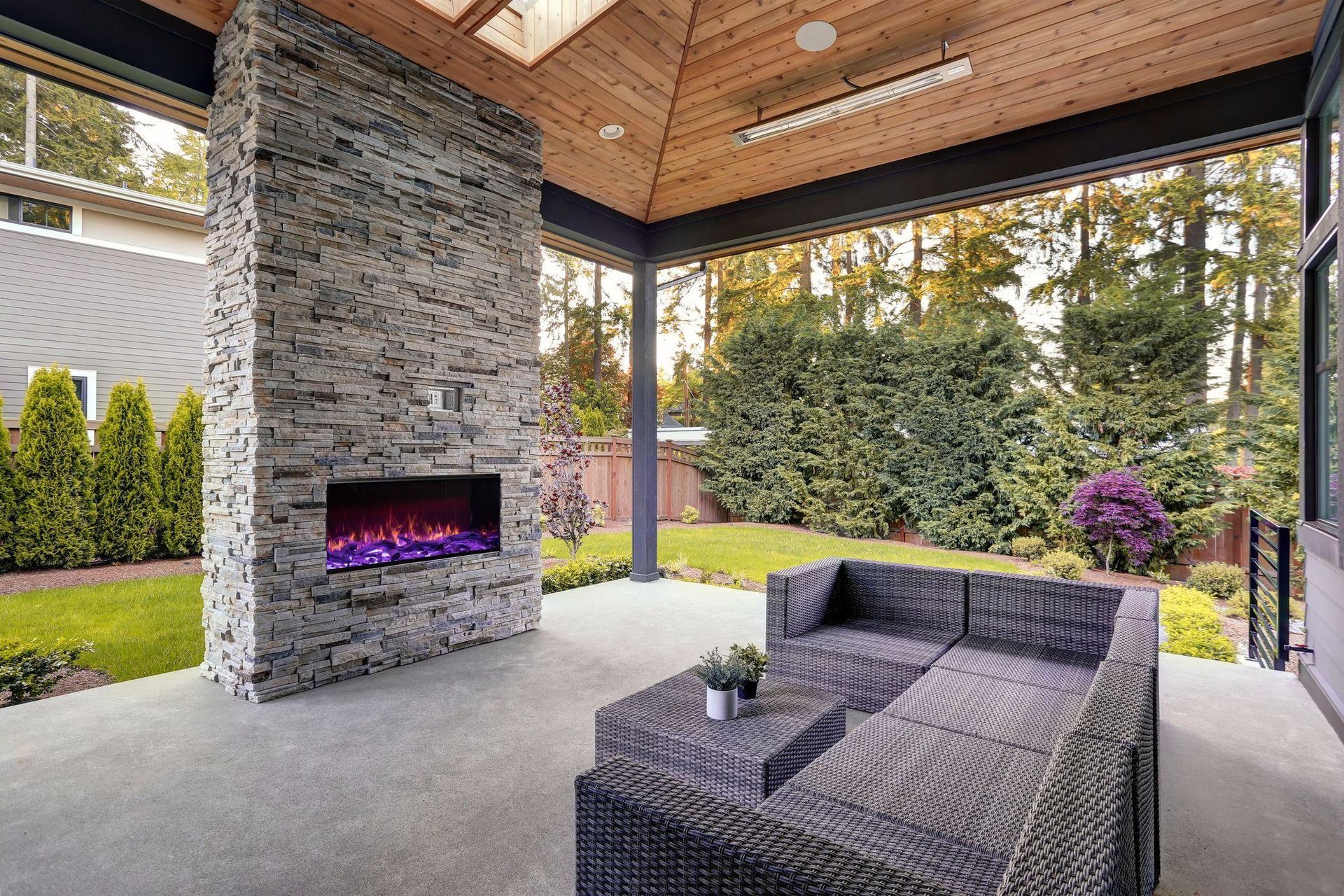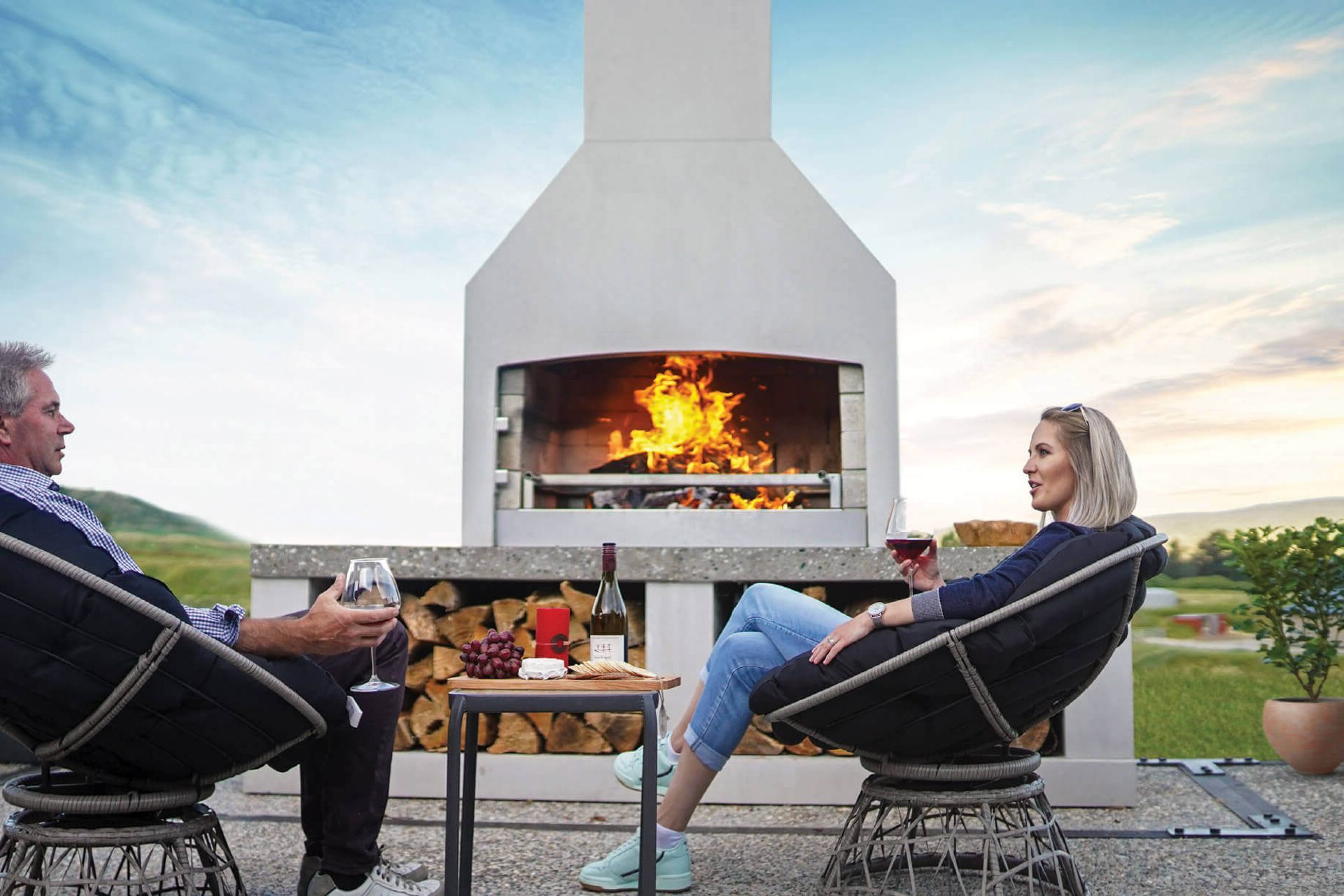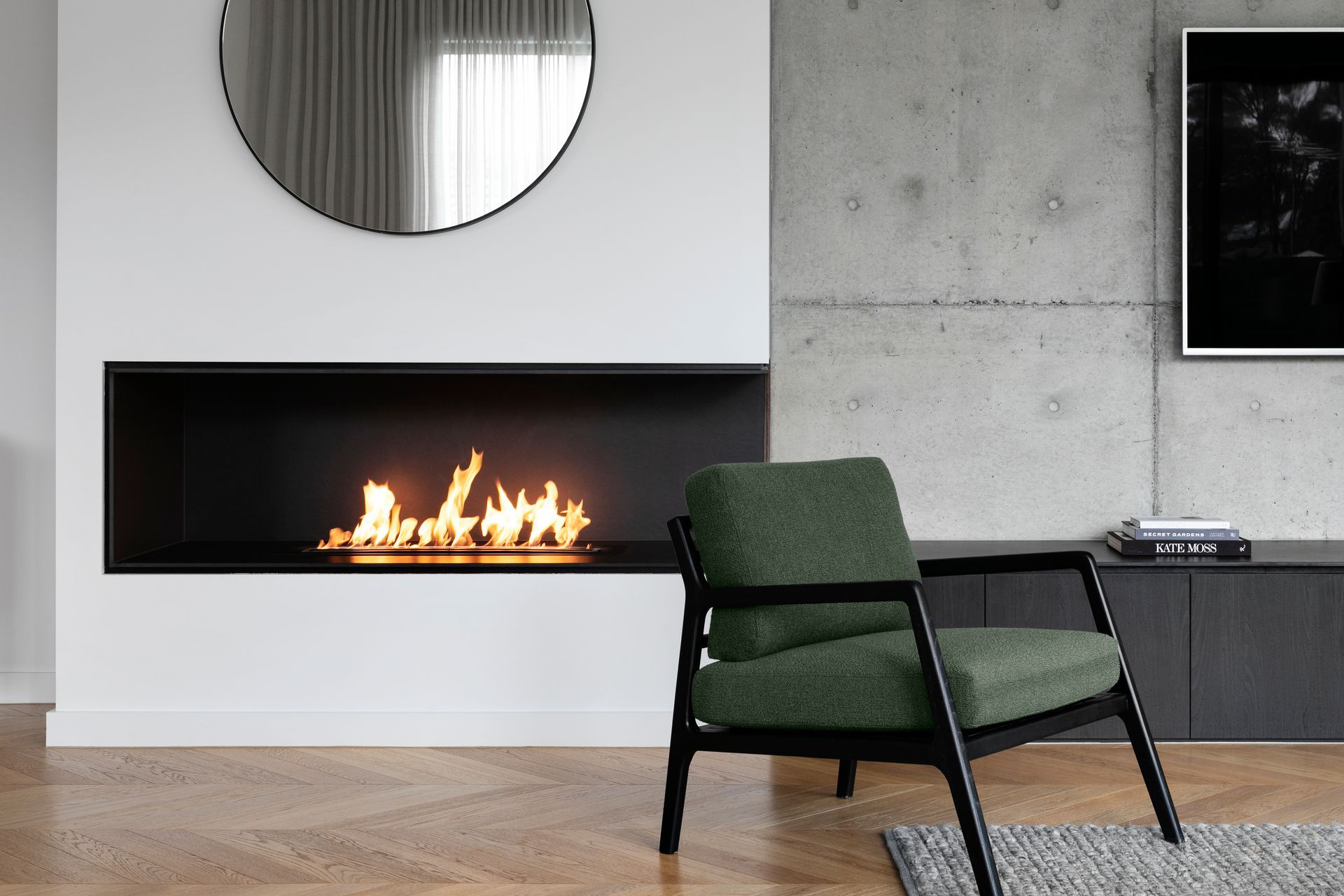25 different types of fireplaces: pros and cons in 2024

When it comes fireplaces, the options are plentiful. You can find everything from different types of traditional wood-burning fireplaces and modern electric or gas models to eco-friendly ethanol fireplaces. Each type has a distinct style and set of features and carries its own set of benefits and drawbacks.
Wood burning fireplaces
Wood burning fireplaces offer the authentic atmosphere of crackling sound of logs, produce heat, and the smoky aroma of burning wood. They are also energy-efficient during power outages and add a classic feel to any home. However, they do require regular cleaning and maintenance to ensure safe operation..
Here are some of the most popular types of wood burning fireplaces to be aware of:
1. Traditional open hearth fireplaces
This is the classic, picture-perfect fireplace we often imagine, complete with a brick or stone surround and a wooden mantel. They offer a wonderful ambience but are less efficient than more modern designs, as a lot of the heat is lost up the chimney.
2. Enclosed fireplaces
These are similar to open hearths but include a glass door to close off the firebox. This improves heat efficiency and safety by reducing sparks and smoke entering the room.
3. Fireplace inserts
Designed to fit into existing open hearths, fireplace inserts improve efficiency by sealing off the firebox and directing more heat into the room. They often include a fan to circulate the heat.
4. Wood burning stove
A freestanding unit with a closed fire chamber, connected to a chimney. They are renowned for their heating efficiency and the cosy atmosphere they create.
5. Potbelly stove
Named for their distinctive bulbous shape, potbelly stoves are compact, efficient, and add a unique decorative element to the room. They're often used in small spaces where a larger fireplace won't fit.
6. Wood pellet stove
These stoves use specially made wood pellets for fuel. The pellets are loaded into a hopper and automatically fed into the burn chamber, which makes them easier to use and maintain than traditional wood stoves.
Advantages of wood burning fireplaces
Ambience: Wood-burning fireplaces offer a unique, traditional feel with the sight, sound, and aroma of crackling logs. This can enhance the atmosphere of your home, making it feel warmer and more welcoming.
Independence from utilities: These fireplaces don't rely on gas or electricity, making them operational during power outages and potentially saving on energy bills.
Variety of types: There are various types and styles to choose from, such as open hearth, enclosed fireplace, and wood-burning stoves. Each type offers different aesthetics, allowing homeowners to choose one that best fits their needs.
Disadvantages of wood burning fireplaces
Maintenance: Wood-burning fireplaces require regular cleaning and maintenance. This includes removing ash, inspecting for creosote build-up, and ensuring the chimney is clear of blockages.
Efficiency: Many traditional wood-burning fireplaces, like open hearths, lose a significant amount of heat through the chimney, making them less efficient compared to other heating options.
Environmental impact: Wood burning fireplaces emit smoke and particulates into the atmosphere, contributing to air pollution. They can also create indoor air quality issues if not properly vented.
Electric fireplaces
Electric fireplaces are heating units that replicate the atmosphere and warmth of traditional fireplaces without the need for wood, gas, or a chimney. They work by drawing in cool air, heating it internally using a heating coil, and gently forcing the warmed air back into the room via a fan. This process is known as the fan-forced coil heating method. While the heater creates warmth, the "flames" you see are produced by LED lights that generate a realistic flame effect, which can often be customised according to your preference.
Here are some types of electric fireplace to be aware of:
7. Wall-mounted electric fireplace
This type of fireplace is hung directly on the wall. They are popular for their modern, sleek design and can fit into small spaces where a traditional fireplace would not. Most units come with a remote control for adjusting heat and flame settings.
8. Electric stove
Designed to resemble traditional wood-burning stoves, electric stoves are freestanding units that can be placed anywhere in the home. They often feature a faux log and flame setup and can provide a decent amount of heat.
9. Electric fireplace insert
These are designed to fit into an existing fireplace opening, providing the look of a traditional fireplace without the need for venting or clean-up. They can be a great way to convert a wood-burning fireplace to electric.
10. Freestanding electric fireplace
These are standalone units that can be placed anywhere in the room. They often mimic the look of traditional fireplaces or stoves and can provide supplemental heating as well as a cosy atmosphere.
Related article: 11 of the best electric fireplaces in 2024
Advantages of electric fireplaces
Ease of use: Electric fireplaces are incredibly user-friendly. They usually involve a simple plug-and-play setup and often come with remote controls for adjusting heat and flame settings.
Zero emissions: Unlike traditional fireplaces, electric models produce no smoke or fumes, making them an eco-friendly choice.
Low maintenance: Without any ash or soot to clean up, electric fireplaces are low-maintenance, requiring only occasional dusting.
Disadvantages of electric fireplaces
Dependence on electricity: Electric fireplaces won't function in a power outage. They also add to your electric bill, particularly if used extensively.
Limited heat output: While electric fireplaces are suitable for supplemental heat, they may not provide enough warmth to heat larger spaces effectively.
Less authentic experience: While many models simulate flames quite well, some people feel that electric fireplaces don't quite capture the charm of a real fire.
Related article: Electric vs. gas fireplaces in Australia: points to consider
Gas fireplaces
A gas fireplace is a heating system designed to replicate traditional wood fireplaces but without the hassle of handling firewood or cleaning up soot and ash. This appliance operates using either natural gas or propane as the fuel source. Unlike traditional fireplaces, which require you to light a fire using wood, gas fireplaces produce flames by burning gas. The result is a constant, steady heat output that can efficiently warm a room or even an entire home, depending on the model and its capacity. It should be noted that gas fireplaces do produce carbon monoxide, so users will need carbon monoxide detectors in their home should they have this types of fireplace.
Here are the different types of gas fireplace:
11. Direct-vented
Direct-vented gas fireplaces have a sealed combustion system. This means they pull air from outside the home for combustion and expel the exhaust back outside, ensuring no indoor air is used or contaminated. They usually require a vent or chimney to direct the exhaust gases out.
12. Vent free gas fireplace
Ventless or vent-free gas fireplaces do not require external venting. This makes installation more flexible. However, since they release combustion by-products into the living space, there are concerns about air quality, and they may not be permitted in all regions or homes.
13. Gas inserts
These are units designed to retrofit into an existing wood-burning fireplace, converting it into a more efficient gas-burning fireplace. They offer the dual advantage of revamping an old fireplace and improving heating efficiency.
14. Gas stoves
Resembling the classic design of wood-burning stoves, gas stoves offer a nostalgic aesthetic with modern efficiency. They're standalone units that can be placed almost anywhere in the home.
15. Gas log fireplace
These are designed for those who love the aesthetic of a traditional wood-burning fireplace but prefer the convenience of gas. Ceramic logs are placed over gas burners to mimic the look of a wood fire. They can be installed in an existing fireplace cavity or be part of a newly constructed unit.
Advantages of gas fireplaces
Efficient heating: Gas fireplaces provide consistent, efficient heat. They can quickly warm up a room, and some models are powerful enough to heat an entire home.
Easy operation: With a gas fireplace, there's no need to chop, store, or haul wood. Starting and maintaining a fire is as simple as flipping a switch or adjusting a dial.
Clean burning: Gas fireplaces produce fewer pollutants compared to wood-burning fireplaces, making them a cleaner choice for the environment and for your home's indoor air quality.
Disadvantages of gas fireplaces
Fuel costs: While the costs can vary depending on the local price of gas, running a gas fireplace typically costs more than burning wood.
Complex installation: Gas fireplaces require a gas line, which can make the installation process more complex and costly, especially if a gas line is not readily available where you want to install the fireplace.
Less authentic look and feel: Some individuals feel that despite advancements in ceramic log design, gas fireplaces do not completely capture the visual feeling and ambience of a traditional wood-burning fireplace.
Outdoor fireplaces
An outdoor fireplace is a built or pre-fabricated structure designed to contain a fire outdoors for warmth, cooking, or aesthetic purposes. It is a central feature that allows homeowners to extend their living spaces outside, encouraging relaxation and entertainment.
Here are some examples of outdoor fireplaces:
16. Traditional outdoor fireplace
Constructed from brick or stone, these are built into your outdoor area, either burning wood or gas. Wood-burning models use logs, while gas models require a natural gas or propane source, ignited via a switch or dial. Smoke is expelled through a chimney.
17. Portable outdoor fireplace
Includes any outdoor fireplace designed for easy relocation. Typically made from lightweight materials, they're easy to assemble and disassemble, and can be wood or gas-burning.
18. Outdoor gas fireplace
A cleaner alternative, these units connect to a natural gas or propane line and are ignited electronically. Often designed to resemble a traditional fireplace, they may include ceramic logs or glass fire beads for aesthetic purposes.
19. Outdoor electric fireplace
The most convenient to use and maintain, they operate by plugging into an electrical outlet. They simulate flames visually, often with artificial logs. Some models can also generate heat.
20. Wood burning fire pit
This traditional type of fire pit uses logs as its fuel source. It provides a classic, natural experience complete with the crackle of burning wood, but requires regular clean-up of ash and burnt wood.
21. Propane fire pit
A propane fire pit uses a propane tank as its fuel source, providing a clean burn without smoke or ash. It's easily ignited with a button or switch, making it a convenient option.
Related article: 13 of the best fire pits in Australia - our top picks
Advantages of outdoor fireplaces
Versatility: Outdoor fireplaces come in a wide range of styles and types, from traditional built-in fireplaces to portable or electric models. This means they can fit a variety of needs, aesthetic preferences, and spaces.
Heat and light: All outdoor fireplace models provide some form of heat and light, which can extend the usability of your outdoor space into cooler seasons or during night-time.
Cooking capability: Traditional outdoor fireplaces often have the capability to be used for cooking, adding a unique and enjoyable element to your outdoor entertainment options. You can roast marshmallows, cook on a grill grate, or even use cast-iron cookware directly on the fire.
Disadvantages of outdoor fireplaces
Maintenance: All outdoor fireplaces require some maintenance. Traditional models need cleaning of ash and soot, while gas and electric models need periodic checks for gas leaks or electrical faults.
Cost: Outdoor fireplaces, especially built-in or gas and electric models, can involve significant costs due to construction or installation fees.
Safety: All types of outdoor fireplaces carry potential safety risks. Open flames can pose a burn hazard or fire risk, gas models could have gas leaks, and electric models need careful usage to prevent electrical issues. Proper installation and supervision are necessary for all types.
Ethanol fireplaces
Ethanol fireplaces, also known as bio-ethanol fireplaces, use bioethanol fuel and don't require a chimney or flue, making them easy to install and portable. They provide real flames and warmth, but without the mess or upkeep associated with traditional wood or gas fireplaces. However, they typically generate less heat than traditional fireplaces, and the cost of bioethanol fuel can be high.
Here are some of the popular types of ethanol fireplace:
22. Wall-mounted ethanol fireplace
This type is mounted directly onto the wall, saving floor space and creating a focal point in a room. Installation varies from model to model, but it generally requires secure attachment to wall studs.
23. Tabletop ethanol fireplace
These compact, portable units can be placed on a table or other flat surface. They're ideal for adding charm and warmth to both indoor and outdoor settings.
24. Ethanol fireplace insert
An insert is designed to fit into an existing fireplace or custom-built space. They're a good option for converting traditional fireplaces to ethanol, as they provide the aesthetic of a real fire without the ash or smoke.
25. Freestanding ethanol fireplace
These are standalone units that can be moved relatively easily. They come in a range of styles and sizes, offering flexibility in placement and room design.
Advantages of ethanol fireplaces
Ease of installation: Ethanol fireplaces don't require a chimney or flue, making them easier to install than traditional fireplaces. This is particularly beneficial for wall-mounted and insert models, which can be added to existing structures without significant renovations.
Portability: Except for wall-mounted models, most ethanol fireplaces are portable. This includes table top and freestanding models, which can be moved according to your needs.
No mess: Ethanol burning fireplaces offer the visual appeal of real flames without the ash, soot, or smoke produced by wood-burning fireplaces. This makes them a clean option, regardless of the model.
Disadvantages of ethanol fireplaces
Heat output: Ethanol fireplaces generally produce less heat than traditional fireplaces, making them less suitable as a primary heat source.
Fuel cost: While the bioethanol fuel used in these fireplaces is eco-friendly, it can be expensive and require frequent refills depending on use.
Safety: Ethanol fireplaces, like any open flame, can pose safety risks. In particular, the ethanol fuel is highly flammable, requiring careful handling. Furthermore, although ethanol generally burns cleanly, it can still produce carbon dioxide, requiring proper ventilation especially in confined spaces.
Finding the right fireplace for your home
As you can see, there is a vast array of fireplace options available to heat both your home and outdoor areas. If you're in the market for a new fireplace, it's worth taking the time to consider your preferred type and style, the dimensions of the area you're aiming to warm, and your budget. By considering these factors, you should have no problem finding a fireplace that satisfies all your requirements.
Related article: How to pick a fireplace that complements your interior aesthetic










